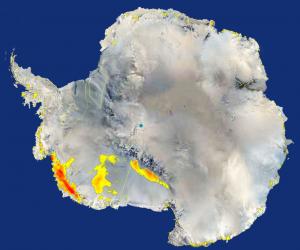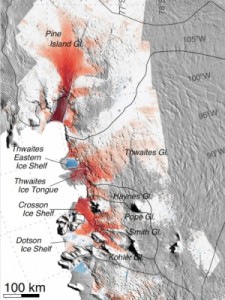May 13, 2014 – After a one day decompression break from my daughter’s wedding I’m back in the saddle today with a story that was splashed all over the wire services in the last 24 hours. In the past I have described how different the impact of global atmospheric warming has been on our two polar regions. In the Arctic we have witnessed a decline in the size of the sea ice pack and increased melts in some of Greenland’s glaciers. But the Antarctic has seen the growth of sea ice although a number of ice shelves in the Antarctic Peninsula have collapsed spawning enormous ice bergs, as big as some U.S. states.
The differences between the two poles can be seen when you look at a picture of our globe. The North Pole sites in an ocean surrounded by continents. The South Pole is centered on a continent surrounded by the largest continuous expanse of open ocean anywhere on the planet. These two very different geographies explain to some degree the different outcomes from atmospheric warming. But now there is new evidence that the world of Antarctica is undergoing something very new. Five glaciers in the West Antarctic ice sheet are undergoing what is described as destabilization. Satellite radar data shows that these glaciers are in danger of catastrophic collapse with the ice retreating not in centuries, but decades. The glaciers involved contain enough water to raise global sea levels 1.2 meters (almost 4 feet). That’s not to say that these glaciers will melt in total. The scientists who did the data study project a 2.5 centimeter rise by 2100 from this West Antarctica source.
When scientists describe a melt as a catastrophic event it is important to understand from where they are coming. The radar data provides detailed records over 40 years of study. It shows the flow rate into the ocean of these glaciers has increased by 77% between 1973 and 2011. Those radar data points that confirm this include ice surface elevation and rates of flow detected by changes in sensor positions on the ice surfaces. That 77% increase is faster than anything anticipated from looking at climate models of Antarctic glaciation. The radar data is also giving scientists a look at the underlying topography of the West Antarctic region and the news here isn’t good either. There appear to be no physical impediments like an elevated ridge to stop the acceleration of ice flowing into the Amundsen Sea which abuts the ice fields.
What would likely trigger a catastrophic collapse? A significant amount of the glaciers as they reach the shores of the Amundsen Sea float over the surface forming ice shelves. Combine this with rising water temperatures in the Amundsen Sea from the upwelling of deep ocean currents containing warmer water from higher latitudes (the global conveyer belt of ocean currents) and it means at some point a series of ice shelf collapses similar to those we have witnessed in the Antarctic Peninsula in recent years.
UC Irvine glaciologist, Eric Rignot, who also works with the Jet Propulsion Laboratory of NASA in Pasadena, California, believes the evidence is in. The glaciers of West Antarctica (seen below highlighted in color on this NASA image of the continent), are in terminal decline. In releasing the content of the report published in the journal Geophysical Research Letters, Rignot has been quoted saying, “The collapse of this sector of West Antarctica appears to be unstoppable….the end appears to be inevitable.”
So what is the timeline for that 1.2 meter sea level rise? Based on current rates of flow and melt Rignot states, “This sector will be a major contributor to sea level rise……A conservative estimate is that it could take several centuries for all of the ice to flow into the sea.”
There is a caveat. The rate of melt and attendant sea level rise is based on two current conditions: GHG levels in the atmosphere and the rate in which the oceans are warming and therefore expanding which causes sea levels to rise. But what if GHG levels continue to rise? Right now CO2 has reached 400 parts per million (ppm). Scientists anticipate based on current fossil fuel burn rates that we will see CO2 climb to 500 ppm or higher by the end of the century based on what we are putting in the air now. Permafrost as it melts in higher latitudes will release significant volumes of methane, a more potent GHG, which will contribute to short-term accelerated warming. The ocean will absorb much of the gas, will continue to warm and expand, and may accelerate the entire destabilization of the West Antarctic ice.
A 2.5 centimeter (1 inch) rise in sea level by 2100 doesn’t seem like a lot. But add the 0.3 centimeter (about 3/16s of an inch) rise in ocean sea levels every year that we are experiencing today because of atmospheric warming and increased CO2 and you begin to wonder when our coastal cities will feel the impact. For cities like New York which has witnessed a sea level rise of 17.8 centimeters (7 inches) in the last century, each additional inch (2.5 centimeters) when combined with a weather event like Hurricane Sandy could mean its death.





















